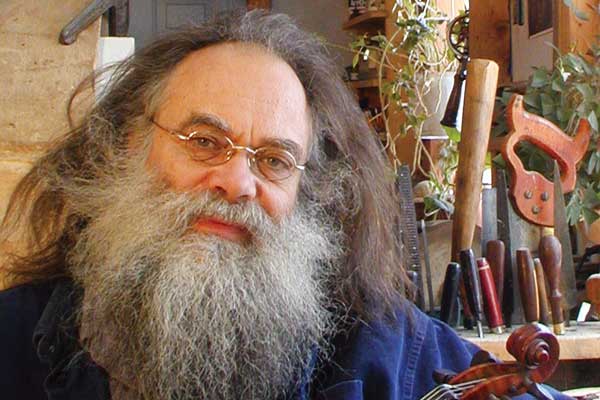Otis Tomas' stringed instruments can be heard all over the world - each with its own inimitable voice.
Three black and white photos stand out in Otis Tomas' workshop. The first one you see is of Father John Angus Rankin conducting a stage full of fiddlers at the third Glendale Festival of Scottish Fiddling in 1975. The shot was taken from behind the popular parish priest, standing on a rickety chair with his arms outstretched like a New Age Moses. Some fiddlers' faces are instantly recognizable - like Mike MacDougall, Jerry Holland and Allie Bennett.
The other two images are long and narrow, hanging side by side. The subjects are tall, mature and handsome. One is of a maple tree and the other, a spruce. They've been cut down since the photos were taken, their wood drying upstairs.
Perched on a stool inside the shop, a man uses a small round-bottomed plane to shape a maple fiddle back. He looks like an artist, if artists have a look: thin-framed spectacles, long, greying hair and beard, a brown sweater festooned with curled shavings, rolled-up jeans and canvas sneakers. When he talks about his work, his words are slow and reflective. "It's really mysterious," he says. "Nobody has really figured out everything."

Otis Tomas is a luthier -a crafter of stringed instruments. The images on his wall bookend the work he does. He turns trees into traditional tunes.
Born and raised in Rhode Island, Otis was in his early 20s and just starting to play the fiddle when he began hearing about the Cape Breton music scene from fellow musicians. At 23, he came to the island to check out the area's traditional fiddle music. It was the year the Glendale picture was taken. Otis was at the performance, in the front row.
"I really liked the place," he says. "The music was great as was the sense of community and the lifestyle. People say Cape Breton is a great place to be poor. I bought a little piece of land and I didn't have to get the big mortgage and buy into that whole thing. I was able to do things on my own terms here, which was great."
In those early days, Otis did whatever he had to do to support himself while he made instruments on the side. He helped on a lobster boat, planted trees, did carpentry work. "I paid my dues for quite a few years," he says.
But Otis fell in love with much more than the island's traditional culture. He also met his future wife, Deanie Cox - now together more than 30 years. They settled on a little piece of land, a tree-covered hillside on the Meadow Road in Goose Cove, Victoria County. Eventually their family expanded to four, with daughter Naomi and son Zachary, now grown.
It's been about 20 years since Otis was able to "give up real work" and become a full-time luthier. He's consistently got at least a year's worth of instrument orders to fill. Not that he's churning them out. He makes between 10 and 14 fiddles a year, each selling for upwards of $4,000 when made with the most "highly figured" wood, referring to the so-called curly or flamed grain found in rare pieces of maple. Otis also creates guitars, mandolins, cellos and even the odd harp.
Don't picture Norm Abram's New Yankee Workshop when you think of Otis' luthier shop -his looks more organic. Plants encroach on a light-filled picture window, the odd empty whiskey bottle basks among the planes, chisels and gauges.
A well-worn stool sits close to a stand holding a yellowed music book, opened to a tune composed by the 18th century blind Irish harper Turlough O'Carolan. A dusty piano slumbers on the opposite side of the room. All that's missing is a cat.
Otis plays his own fiddle almost every day, but the workshop really awakens once or twice a week, when his buddies drop by. "I don't really pursue the performance thing," he says. "We mostly just have parties or sessions in the workshop... we have some pretty good ones." Performers might include Deanie and Paul MacDonald on guitar, fellow luthier David "Papper" Papazian and lighthouse keeper Paul Cranford on fiddle.
Otis says he draws inspiration from old Italian masters like Antonio Stradivari and Nicolo Amati, and has posters on the wall displaying some of their violins. But he doesn't try to copy them. He can't. "The wood is different," he says. "So every fiddle is different."
He explains that like a human body, a fiddle has a belly, a back, ribs, a neck… and a voice. Its voice depends on how its body is put together. Like the human voice, no two fiddle voices are alike.
Local fiddlers Brenda Stubbert, Dougie MacDonald and Paul Cranford play Otis Tomas fiddles and musician Laura Smith plays his guitars. Although about half of his instruments go to the United States, they can be heard around the world. He recently sent a cello to Hong Kong and a violin to Denmark. He says it isn't hard to package them up and send them off. "By the time you let one go, you're already excited about the next one."
